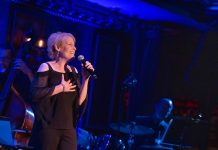Czech pianist Martin Kasik has an important historic connection with Washington despite relatively infrequent visits here. He was a 1999 winner of the Young Concert Artists series, which launches careers for a handful of instrumental and vocal performers every year, and still fills out a schedule every season in The Kennedy Center Terrace Theater.

So it was welcome to see Mr. Kasik back in Washington on Wednesday evening at the Embassy of the Czech Republic, as part of the very active Embassy Series of concerts. Now considered one of the leading teachers of advanced piano students in the Czech Republic – a country that boasts of more music conservatories per capita than almost any other – Mr. Kasik brought his mature performance skills to bear on a program of Beethoven, Ravel, and Prokofiev.
Particularly notable was Mr. Kasik’s juxtaposition of two works each by Maurice Ravel and Sergei Prokofiev, all from the early 20th century. Mr. Kasik’s technique tends toward the golden-toned and flowing, and is perfectly attuned to the distinct sonorities of Ravel’s music.
He began the Ravel pair with the somewhat alarmingly named Pavane pour une infante défunte (“Pavanne for a Dead Princess”), which is really an imaginative title on Ravel’s part honoring a Spanish Basque tradition learned from his mother of playing certain types of music at certain types of funerals, and is not really a reference to an actual event. The lovely melody of the Pavane, which became something of a hit tune in its time, rang beautifully under Mr. Kasik’s fingers.
In a larger Ravel work, simply called Sonatine but essentially a work taking the boundaries of a full 18th-century piano sonata and applying Ravel’s more luxuriant harmonies and colors, Mr. Kasik expanded his own palette and demonstrated pure piano chops from start to finish. Ravel himself would have been pleased with the performance, given that he himself felt he couldn’t play the difficult final movement despite writing it.
Sergei Prokofiev’s music may date from a similar era but has harder edges, and here Mr. Kasik had mixed success. Prokofiev’s brief Prelude No. 7 (from a series of ten piano pieces collected as Prokofiev’s Opus 12) was an effective spraying and fluttering of notes across the keyboard. In the greater variance of Prokofiev’s rather wild Piano Sonata No. 3, Mr. Kasik was a little heavy on the pedal, and an opening volley of repetitive E major chords tended to smear together rather than announce themselves like a machine gun, as other pianists are able to achieve.
Mr. Kasik did effectively change up the style throughout the piece – many of Prokofiev’s sonatas throw numerous moods together rather than separate them by “movements” with actual pauses – and certainly kept the audience’s rapt attention throughout the sonata’s intense 10-minute span.
The beginning of Mr. Kasik’s concert was devoted to Beethoven, and featured a deliberately ironic pair of works chosen from among Beethoven’s 32 piano sonatas. The Piano Sonata No. 14 is universally known as the Moonlight Sonata even though scholars believe that Beethoven wasn’t trying to paint a picture and was really trying to downplay the opening movement (which does indeed sound like moonlight shimmering on the water) in favor of a complete reversal of mood in the raucously active final movement. In any case, Mr. Kasik did a fine job making this start-to-finish transition and nicely pulsed the last movement’s huge, ultra-fast arpeggios across the piano to a definitive conclusion.
By contrast, Beethoven’s Piano Sonata No. 26 is, along with the Pastoral Symphony or Symphony No. 6, one of the master composer’s very few “program works” that really do have a story to tell. The 26th sonata has various nicknames in various languages that all add up to the Farewell Sonata – not farewell in the sense of one’s own life, but with reference to political and military events of the time. The sonata essentially depicts Napoleon’s attack on Vienna in 1809, the departure or “farewell” of Beethoven’s patron Archduke Rudolph and other nobility, and triumphant return to Vienna in 1810 after Napoleon was repulsed.

It’s a complex work and Mr. Kasik’s performance was affected by the instrument he was playing on – a “Petrof” from the Czech Republic installed in the embassy’s great hall. The piano has a heavy-sounding middle register but an overly bright upper register, and particularly when Beethoven wrote out high octaves in the third movement that call up the idea of pealing bells sounded in celebration, the sound was rather “jumpy” or “pingy” in the hall.
But in a way, that’s part of the charm of the Embassy Series, which brings international artists – sometimes directly related to their host location in Washington and sometimes not – to embassies and ambassador’s residences throughout the city. Each venue is unique and authentic to its culture. And in its own small way, the series attempts to bridge the gap of international understanding, as Embassy Series Founder Jerome Barry explains in this charming 2½-minute video.
At a time of year when many concert series are starting to look toward the end of their seasons, the Embassy Series has no fewer than seven events remaining (although several are nearly sold out or have relatively limited seating in the first place). It’s a pricier ticket than most but invariably comes with a social hour, refreshments or more (at the Czech Embassy it was a full buffet dinner), and intriguing people to meet, often with the host nation’s own ambassador to the United States in attendance. Mr. Barry himself is a very devoted “ambassador” for the program, which looks to bring important artists like Mr. Kasik back to Washington, or into Washington for the first time, for years to come.
Running Time: Approximately 90 minutes,with one 15-minute intermission.
Pianist Martin Kasik performed on April 15, 2015 in the Embassy Series at the Embassy of the Czech Republic – 3900 Spring of Freedom Street NW, in Washington, DC. For future concerts in the Embassy Series, see their performance schedule. For this season’s Young Concert Artists events in The Kennedy Center Terrace Theater, see their website.





